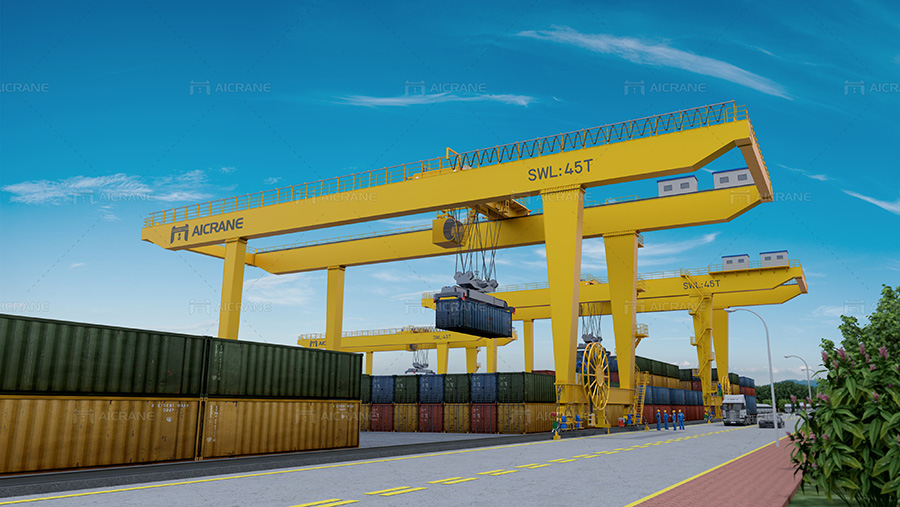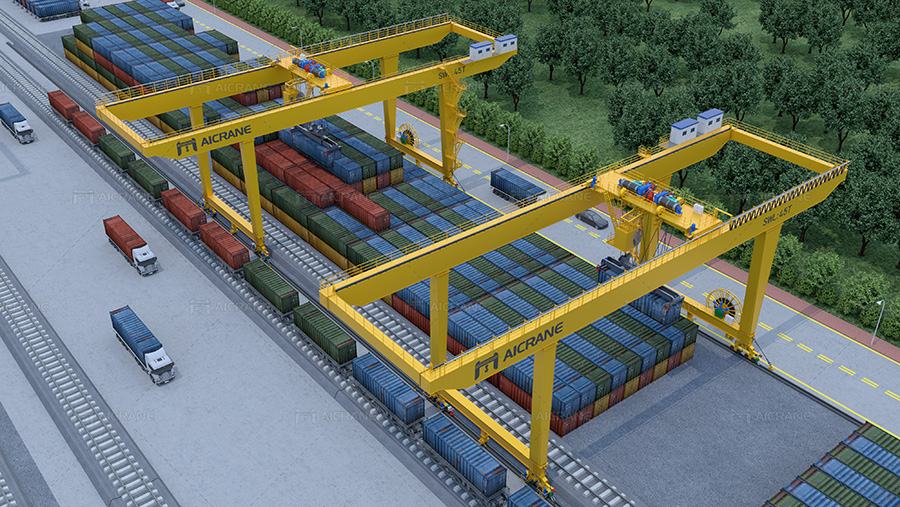Rail-mounted container gantry cranes (RMGs) are critical components in the logistics and transportation industries, especially in ports and container terminals. These cranes are designed to handle the heavy lifting of shipping containers, but their performance and longevity can be significantly impacted by harsh environmental conditions. Designing RMGs for such environments requires careful consideration of various factors to ensure reliability, safety, and efficiency.

1. Understanding Harsh Environments
Harsh environments can include extreme temperatures, high humidity, corrosive elements, strong winds, and heavy snowfall. Each of these conditions poses specific challenges for rail mounted container gantry crane design:
- Extreme Temperatures: Both high and low temperatures can affect the mechanical properties of crane materials. Cold temperatures can cause brittleness in materials, while high temperatures can lead to thermal expansion and potential deformation.
- High Humidity: Increased moisture can accelerate the corrosion of metal components, leading to structural weaknesses and increased maintenance needs.
- Corrosive Elements: Environments near seas or industrial sites might expose cranes to salt, chemicals, or other corrosive substances, necessitating protective measures.
- Strong Winds: Cranes operating in windy conditions must be designed to handle additional loads and stresses to prevent tipping or structural failure.
- Heavy Snowfall: Snow and ice can add significant weight and load to the crane, impacting its stability and operational efficiency.
2. Material Selection
The choice of materials is crucial in designing RMG cranes for harsh environments. Materials must be selected based on their resistance to environmental stresses:
- Corrosion-Resistant Materials: For coastal or industrial areas, using materials with high corrosion resistance, such as stainless steel or specialized coatings, is essential. Hot-dip galvanized steel and epoxy coatings can also provide protection against corrosion.
- Temperature-Resistant Materials: Materials should be chosen based on their ability to withstand temperature extremes. High-strength, low-temperature steel may be required for cold climates, while heat-resistant alloys might be necessary for hot environments.
- Impact-Resistant Materials: In areas prone to high winds or flying debris, materials with high impact resistance can prevent damage to critical crane components.
3. Structural Design
The structural design of RMGs must account for the additional stresses imposed by harsh environmental conditions:
- Reinforced Structures: Reinforcing key structural components, such as beams and supports, can enhance the crane’s ability to handle increased loads and stresses. Structural reinforcements may include thicker steel plates or additional bracing.
- Wind Load Considerations: For cranes in windy areas, the design should include considerations for wind load effects. This can involve aerodynamic design modifications and enhanced structural stability to prevent tipping or excessive sway.
- Snow and Ice Load Handling: Design features such as heated components or snow guards can help manage the additional weight from snow and ice. The structural design should ensure that the crane can safely operate under these conditions.

4. Protective Coatings and Treatments
Applying protective coatings and treatments is vital for enhancing the durability of RMGs in harsh environments:
- Corrosion Protection: Apply anti-corrosive coatings to all exposed metal surfaces. Regular maintenance and reapplication of coatings can extend the lifespan of the crane.
- Heat and Cold Protection: Use thermal insulation and heat-resistant coatings to protect components from extreme temperatures. Insulation can also improve energy efficiency by reducing heat loss or gain.
- Dust and Debris Protection: In dusty or debris-prone environments, sealing components and using dust-resistant coatings can prevent damage and maintain operational efficiency.
5. Maintenance and Inspection
Regular maintenance and inspection are critical for ensuring the continued performance and safety of RMGs in harsh environments:
- Routine Inspections: Develop a comprehensive inspection schedule that includes checking for signs of corrosion, wear, and damage. Use advanced inspection techniques such as ultrasonic testing and infrared thermography to detect issues early.
- Preventive Maintenance: Implement a preventive maintenance program that includes cleaning, lubrication, and replacement of worn parts. This can help prevent unexpected breakdowns and extend the crane’s operational life.
- Training and Procedures: Ensure that maintenance personnel are trained to understand the specific challenges of working in harsh environments. Develop and follow detailed maintenance procedures to address environmental impacts effectively.
6. Operational Considerations
Operational practices can also influence the performance of RMGs in harsh environments:
- Operational Limits: Set operational limits based on environmental conditions, such as wind speed or temperature ranges, to prevent overloading or damage. Implementing automatic shutdown systems can help protect the crane from operating under unsafe conditions.
- Operator Training: Train operators to recognize the effects of environmental conditions on heavy duty gantry crane performance. Proper training can help operators make informed decisions and adjust their operating practices as needed.
- Emergency Procedures: Develop and communicate emergency procedures for extreme weather conditions or other environmental challenges. Having a clear plan can help mitigate risks and ensure a quick response to emergencies.
7. Technological Innovations
Incorporating modern technology can enhance the performance and durability of RMGs in harsh environments:
- Smart Sensors: Use sensors to monitor environmental conditions, crane performance, and component health. Data from these sensors can provide real-time insights and help with predictive maintenance.
- Automation: Implement automation and control systems that can adjust crane operations based on environmental factors. Automated adjustments can improve safety and efficiency.
- Advanced Materials: Explore new materials and technologies designed specifically for harsh environments. Innovations in material science can lead to improved performance and longer-lasting components.
8. Conclusion
Designing rail-mounted container gantry cranes for harsh environments requires a comprehensive approach that addresses material selection, structural design, protective coatings, maintenance, operational considerations, and technological innovations. By understanding the specific challenges posed by environmental conditions and implementing appropriate design strategies, you can ensure that RMGs operate reliably and efficiently, providing long-term value and safety in demanding conditions. Learn more: https://aicraneliftingsolution.com/